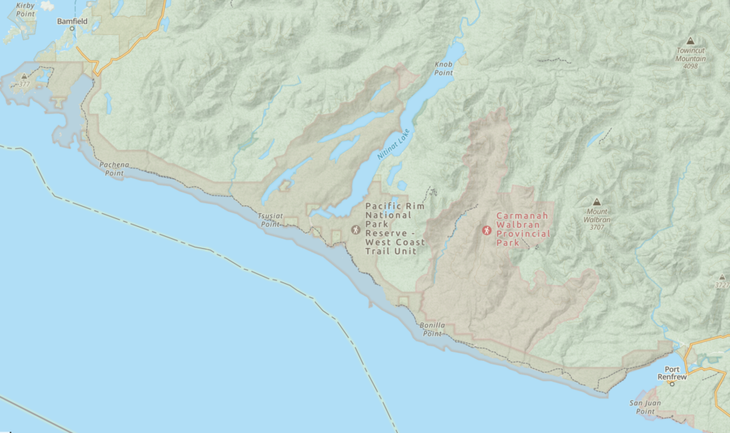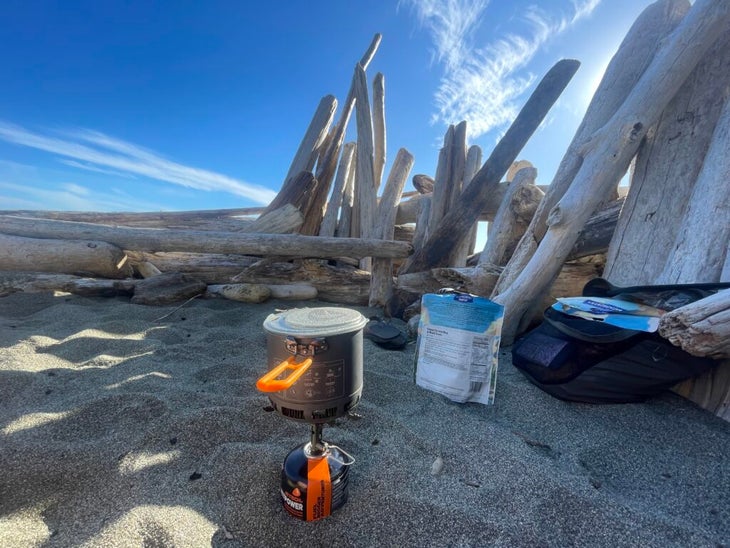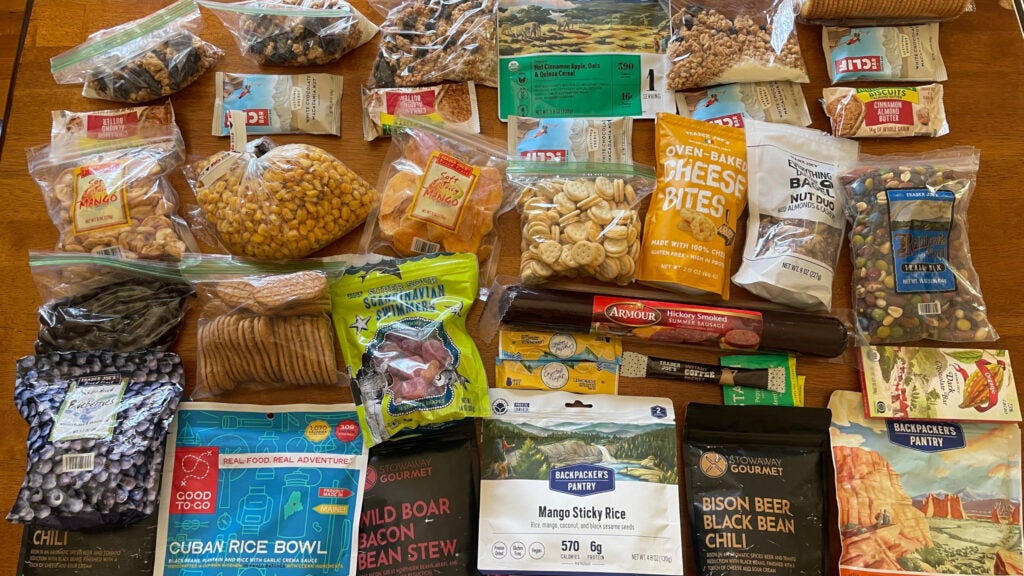“], “filter”: { “nextExceptions”: “img, blockquote, div”, “nextContainsExceptions”: “img, blockquote, a.btn, a.o-button”} }”>
Heading out the door? Read this article on the new Outside+ app available now on iOS devices for members!
>”,”name”:”in-content-cta”,”type”:”link”}}”>Download the app.
On longer hikes, my food situation tends to go one of two ways: Sometimes, I spend every snack break rationing gummy worms, anxious that I won’t have enough food to keep me fueled for the duration of my trip. But more often than not, I return home with a stuff sack half full of unopened bars, baggies of crushed chips, and globs of melted candy. Stressing about food and carrying extra weight is no fun, but I have no one to blame but myself; until recently, I’ve approached backpacking meal planning using the eyeball method. I’d lay out an array of snacks and meals, vaguely grouping items by day and imagining how much I might consume during every break on the trail. Then into the bag it would all go. On overnighters or weekend-long trips, I could get away with it, but this method is unscientific and, admittedly, very flawed, especially for long hikes.
Being properly fueled makes all the difference when it comes to my enjoyment of a hike, so for a recent weeklong trip on Vancouver Island’s West Coast Trail, I decided to do some more careful meal planning, with the help of some online tools.
Counting Calories
The hardest part of packing hiking food is determining calorie needs, which can vary hugely per person and based on factors like mileage, elevation gain, temperature, terrain, and more. Instead of guessing, I turned to a planning tool designed for hikers. Backcountry Foodie’s Hiking Calorie Calculator allows you to input a series of factors about yourself, like height and weight, and about your planned itinerary, including your average hiking pace and the type of terrain you’ll be traveling over. The calculator accounts for 14 different factors and spits out a personalized daily calorie target. The tool was created by Aaron Owens Mayhew, a registered dietitian and long-distance hiker who curates meal plans and recipes for backpackers and thru-hikers.
The first thing I noticed about the calculator is that even slight adjustments to my pace or terrain type had a drastic effect on the calorie totals. For example, I had the option to choose between loose sand, packed sand, and dirt trail. I knew my hike (which was half on the beach, half through the forest) would involve some of each, but changing this factor made my daily totals swing by 1,000 calories or more. Instructions for the calculator warn that certain inputs can result in inflated estimates: For example, if you select 10 to 15 percent grade as the steepness for your hike, the calculator assumes you’ll be climbing that grade the entire time—it can’t account for the ups, downs, and flats that are characteristic of most backpacking trips. Backcountry Foodie suggests taking this inflation into account, and to average the results of high and low inputs to get a more accurate calorie count.

To deal with this variation, I asked the calculator to generate a series of estimates, changing factors each time to represent smaller segments of my hike. The results ranged from 3,400 to 4,900 calories per day, depending on what the terrain, mileage, and other varying factors looked like. For example, if my entire backpacking trip reflected the easiest sections (flat, packed trail, last-day pack weight, and an easy pace), I’d need to consume 3,400 calories per day. If my entire hike featured deep sand, a fast pace, and a full pack, I’d need to eat much more. This is a wide range, but it gave me something solid to work off of.
To determine my final daily calorie needs, I compared this information with data from my Garmin Instinct watch, which shows me how many calories I burn on an average day and during my tracked activities. Based on this information, and an understanding of my own eating habits on backpacking trips, I determined that I’d need to pack between 3,500 and 4,000 calories per day, with more food reserved for the biggest mileage days of the hike. I’d pack an average of around 3,800 calories per day.
Translating Calories to Snacks
Then came the fun part: Grocery shopping. I went on a snack spree at Trader Joe’s, loading up on my favorite nut mixes, dried fruits, candy, and cheese. Then I took a trip to WinCo, where I raided the bulk aisle. Finally, I selected some meals from my freeze-dried stash, and dumped the whole pile out on my kitchen counter.
In order to meet my daily calorie needs, I’d need to study nutrition labels, measure out portions, and decide what I’d eat each day of my hike. I even broke out my kitchen scale so I’d have an accurate estimation of the calorie totals for what I was bringing. No better way to organize all of this information than with a spreadsheet. Here’s a sample from the Google Sheet I used to calculate calorie totals based on my meals and snacks for each day.
| Day 2 food | Day 2 calories |
| Granola, milk, berries | 350 |
| Chocolate covered espresso beans | 140 |
| Clif bar | 260 |
| 2 oz dried mango (3-4 pieces) | 200 |
| Apple rings | 120 |
| Everything bagel nut mix | 360 |
| Cheese crackers | 150 |
| 2 string cheese | 100 |
| Sour Swimmers candy | 230 |
| Nutter Butters | 150 |
| Corn nuts | 250 |
| Trail mix | 420 |
| Freeze-dried chili | 705 |
| 4 peanut butter cups | 280 |
| Total | 3,715 |
I repackaged some foods into individual portions, scooping ⅔ cup granola, 2 tablespoons of dry milk, and a handful of freeze-dried berries into baggies for six neat, 350-calorie breakfasts. Others, like my candy, crackers, summer sausage, and dried mango I left in their original packaging, knowing I’d steadily eat through my supply over the course of the week. This allowed me some flexibility to eat what I wanted each day, rather than feeling pressure to consume exact portions on a daily schedule.
I factored in a few wild cards: I’d eat a large breakfast in town on day one, meaning I could carry fewer snacks. Mid-way through our hike, we’d reach a crab shack where I could buy a hot lunch and soda, eliminating the need to carry a chunk of calories for that day.
I decided I was OK factoring in some guesswork here; I’d err on the side of carrying too many calories, knowing my bottomless pit of a boyfriend could help me polish off any extra food if I got sick of carrying it. Plus, I knew we’d have plenty of downtime while camping on the beach, and I’d appreciate having a variety of snacks to munch on.
The Results
At the outset of my weeklong hike, I felt rich with snacks. My pack was inevitably on the heavier side, but I didn’t experience a shred of food anxiety like I have in the past—after all, spreadsheets don’t lie. Midway through the trip, I realized I was undereating according to my plan. The hiking had been easier than expected, so we’d stopped for fewer snack breaks early on. So, on day three, I dumped my entire food bag onto a sleeping pad and took inventory; I could afford to ramp up my snacking significantly. I planned a long lunch stop at a scenic spot for our next day’s itinerary, and allowed myself to snack with abandon over card games during long afternoons in camp. It took an active effort to eat enough, but I felt energized, satiated, and pleased with the variety of snacks I’d brought.

Ideally, I would have hiked out on the last day with just a few emergency rations left in my pack. In the end, I didn’t perfectly nail it—we were faster than expected and ended up finishing a day early, so I had extra food after all. By seeking out uncrowded camps along our route, we’d expedited our itinerary while still enjoying a leisurely pace with plenty of time for whale watching from the beach. The food I had left over was about a day’s worth; if we had stuck with the original plan, I would have had just the right amount of food. The Backcountry Foodie Calorie Calculator will definitely become a regular part of my trip planning routine from here on out.
Despite the extra pack weight on the last day, there was one big upshot to having extra food: Now I had plenty of car snacks for the long ride home.
